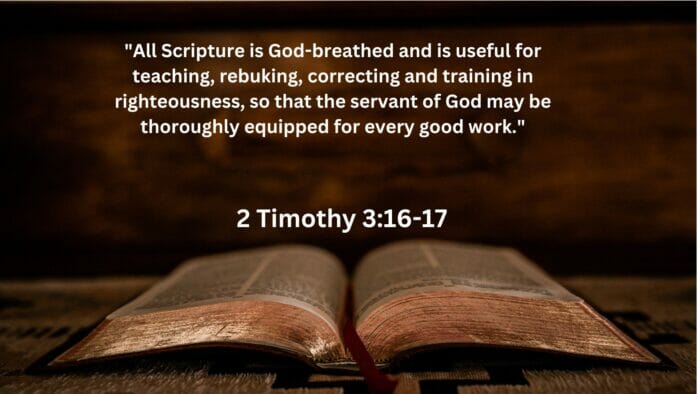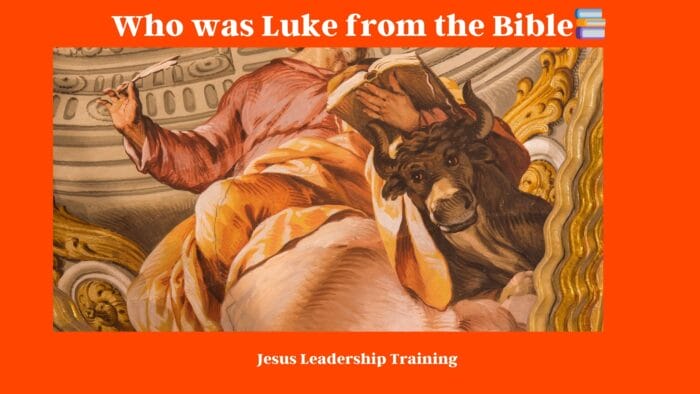Who was Luke from the Bible – Luke, known as Luke the Evangelist, is a prominent figure in Christianity, recognized for his contributions as an author to the New Testament. Little is known about his personal life, but it is widely agreed upon that he was a physician and the only Gentile writer in the New Testament. As a companion of Saint Paul the Apostle, Luke was deeply involved in the early Christian movement, as evidenced by his well-documented presence in Paul’s letters.

Luke’s writings, specifically the Gospel of Luke and the Acts of the Apostles, are held in high regard for their literary style and unique content. As an evangelist, he sought to present an accurate and compassionate portrayal of Jesus, emphasizing Jesus’ ministry to the downtrodden and marginalized. Luke’s Gospel and the Acts of the Apostles also shed light on the early Christian church’s growth, its struggles, and its theological themes, which have had a significant impact on Christian teachings and legacy throughout the centuries.
Table of Contents
Key Takeaways
- Luke, a physician and Gentile, is the acclaimed author of the Gospel of Luke and the Acts of the Apostles.
- His writings focus on Jesus’ ministry and the growth of the early Christian church, featuring valuable theological themes.
- Luke’s portrayal of Jesus and his detailed documentation have had a lasting influence on Christianity’s development and legacy.
Life of Luke

Birth and Early Life
Little is known about Luke’s early life, but he is believed to be a Gentile and likely received a Greek education, as evident from his highly educated Greek writing style in the books of Luke and Acts1. He is considered one of the most literary authors of the New Testament.

Companion of Paul
Luke was a companion of Paul the Apostle, joining him on missionary journeys throughout the Mediterranean region2. Often referred to as a dear friend of Paul, he was with the apostle during some of his most significant experiences, including imprisonments and trials. Luke’s close association with Paul is evident in the way he documents Paul’s teachings and events in the Acts of the Apostles.
some bullet points summarizing the life of Luke:
- Luke was a Christian saint and traditionally regarded as the author of the Gospel of Luke and the Acts of the Apostles in the New Testament.
- He is believed to have been a physician and is sometimes referred to as “Luke the Evangelist” or “Luke the Physician.”
- Luke’s Gospel is known for its detailed and compassionate portrayal of Jesus’ life and ministry, including the parables of the Good Samaritan and the Prodigal Son.
- He was likely a Gentile (non-Jewish) by birth, making him one of the few non-Jewish authors of the New Testament.
- Luke is thought to have been a close companion of the Apostle Paul and traveled with him during his missionary journeys.
- His medical background is suggested by references in his writings to illnesses and healing, as well as his meticulous attention to detail.
- Luke’s Gospel includes the only account of the Nativity story, including the annunciation to Mary and the visitation of the shepherds.
- He emphasized the role of women in Jesus’ ministry and was known for his compassion for the marginalized and the poor.
- The traditional iconography of Luke often includes a winged ox or bull, symbolizing sacrifice and service, as well as the Gospel’s emphasis on Jesus as a sacrificial offering.
- Luke’s writings contributed significantly to the early Christian understanding of Jesus’ life, teachings, and the spread of Christianity in the early Church.
Luke the Physician
Luke was a skilled physician, which made him an invaluable asset during his travels with Paul. His medical background allowed him to minister to the physical needs of those he encountered while spreading the gospel. He also demonstrated compassion and sensitivity when writing about people’s infirmities and ailments in his accounts. This expertise might have been essential, given the many challenges and beatings faced by Paul during his missionary work3.
Medical practices during the First century were significantly different from modern medicine, reflecting the limited knowledge and resources available at the time. Here is a table outlining some of the common medical practices and treatments that a trained doctor might have employed during that era:
| Medical Practice | Description |
|---|---|
| Herbal Remedies | Doctors relied heavily on the use of herbs and plants for various medicinal purposes. These included remedies for pain relief, infections, and digestive issues. |
| Bloodletting | Bloodletting was a common practice, believed to balance the body’s humors and treat various ailments. It involved intentionally bleeding the patient using lancets or leeches. |
| Surgery | Surgical procedures were limited and often performed as a last resort. Infections were common due to a lack of sterilization techniques, and surgeries were often performed in unsanitary conditions. |
| Prayer and Superstition | Spiritual and superstitious beliefs played a significant role in healthcare. Doctors often invoked the help of deities or used amulets and charms for healing. |
| Dietary Recommendations | Doctors provided dietary advice, emphasizing the importance of a balanced diet to maintain health. Certain foods were believed to have medicinal properties. |
| Ointments and Poultices | Topical ointments and poultices made from various substances like animal fats, honey, and herbs were applied to wounds and skin conditions. |
| Massage and Physical Therapy | Manual therapies such as massage and manipulation were used to relieve pain and discomfort. |
| Observation and Diagnosis | Doctors relied on careful observation of symptoms and patient history to make diagnoses. They often lacked knowledge of specific diseases and relied on general descriptions. |
| Dental Care | Basic dental care included tooth extraction and remedies for toothaches, often using crude instruments. |
| Education and Apprenticeships | Medical knowledge was passed down through apprenticeships, and doctors learned from practical experience rather than formal medical education. |
It’s important to note that medical practices during the First century were shaped by the prevailing beliefs and limited scientific understanding of the time. Many of these practices, while well-intentioned, would be considered ineffective or even harmful by today’s medical standards.
Luke the Historian
In addition to his role as a physician, Luke is known as a Greek-trained historian who meticulously documented events in both the Gospel of Luke and the Acts of the Apostles. His writings provide valuable insights into the life of Jesus and the early Christian Church, specifically highlighting Jesus’ ministry and the spread of Christianity in the years following Jesus’ crucifixion and resurrection. As a skilled writer, he contributed significantly to the understanding of the New Testament and the historical context of early Christianity.
Certainly, here is a table representing a timeline of the writing and canonization of the four Gospels in the New Testament:
| Gospel | Approximate Writing Date | Canonization Date |
|---|---|---|
| Gospel of Mark | 60-70 AD | 4th Century AD |
| Gospel of Matthew | 70-85 AD | 4th Century AD |
| Gospel of Luke | 80-90 AD | 4th Century AD |
| Gospel of John | 90-100 AD | 4th Century AD |
Please note that the exact dating of the Gospel texts can vary slightly among scholars, and there is ongoing debate about the precise dates of their composition. Additionally, the process of canonization, which involved determining which texts would be included in the New Testament, took several centuries and varied among different Christian communities and councils. The dates provided in the table are approximate and represent general scholarly consensus. The formal recognition of these Gospels as part of the New Testament canon occurred in the 4th century AD.
Footnotes
- Luke the Evangelist – Wikipedia ↩
- Saint Luke | Biography, Feast Day, Patron Saint Of, Facts, & History ↩
- Who Was Saint Luke? The Beginner’s Guide – OverviewBible ↩
The Writings of Luke

The Gospel of Luke
Luke, a physician and the only Gentile author in the New Testament, is known for his contributions to the Bible through two distinct works: the Gospel of Luke and the Acts of the Apostles. These texts together form a cohesive narrative about Jesus’ life, teachings, and the early Christian church. The Gospel of Luke, considered one of the most beautifully written books, focuses on the life of Jesus Christ, his teachings, and the redemption offered through him1.

Luke wrote his gospel to provide an orderly and accurate account of Jesus’ life and ministry. He addressed his work to Theophilus, who was possibly a high-ranking Roman official or a generic name representing all those who seek the truth2.
Certainly, here is a table explaining the early writing materials available to Luke the Apostle:
| Writing Material | Description |
|---|---|
| Papyrus | Papyrus was one of the primary writing materials available during Luke’s time. It was made from the pith of the papyrus plant and used to create scrolls and codices. |
| Parchment/Vellum | Parchment, also known as vellum, was another writing material made from animal skins, typically from sheep or goats. It was more durable than papyrus and suitable for long-lasting documents. |
| Ink | Luke would have used ink to write on papyrus or parchment. Ancient inks were typically made from various materials, including soot, charcoal, and water. |
| Quills | Writing instruments called quills were commonly used for writing. These were made from the feathers of birds, and the tip was cut to create a nib for dipping in ink. |
| Writing Stylus | In some cases, Luke may have used a writing stylus on wax tablets. These tablets had a surface of wax on which text could be inscribed and then smoothed over for reuse. |
| Scroll | Scrolls were a common format for written documents during Luke’s time. They consisted of long sheets of papyrus or parchment, rolled up for storage and reading. |
| Codex | The codex was an early form of a bound book, made by stacking and binding sheets of papyrus or parchment. Luke may have used codices for his writings. |
| Libraries and Collections | Luke may have had access to existing libraries or collections of scrolls and writings, which could have served as references for his Gospel. |
These were the primary writing materials and tools available to Luke the Apostle as he undertook the task of writing the Gospel of Luke. These materials would have been essential for recording and preserving his accounts of Jesus’ life and teachings.
With a unique perspective as a Gentile author, Luke emphasized Jesus’ concern for the outcasts, sinners, and non-Jewish people. His gospel contains parables and events not found in other gospels, such as the parables of the Good Samaritan and the Prodigal Son3.
The Acts of the Apostles
The Acts of the Apostles carries forward the story from the ascension of Jesus Christ to the spread of the Christian faith throughout the Roman Empire. It serves as a crucial transition between the gospels and the letters of Paul in the New Testament4. Acts provide a historical account of the early church, including the conversion and ministry of the Apostle Paul5.
Much like the Gospel of Luke, the Acts of the Apostles is addressed to Theophilus, further establishing the connection between the two books6. Acts focuses on the works of the Holy Spirit in guiding the apostles and the early church and highlights the importance of fellowship, community, and spreading the message of Jesus to both Jews and Gentiles. Through Acts, we gain insight into the lives, challenges, and triumphs of the apostles, particularly Peter and Paul7.
Footnotes
- https://www.biblegateway.com/resources/encyclopedia-of-the-bible/Gospel-Luke ↩
- https://en.wikipedia.org/wiki/Luke_the_Evangelist ↩
- https://www.gotquestions.org/Luke-in-the-Bible.html ↩
- https://www.crosswalk.com/faith/bible-study/5-things-to-know-about-luke-from-the-bible.html ↩
- https://www.biblegateway.com/resources/encyclopedia-of-the-bible/Gospel-Luke ↩
- https://en.wikipedia.org/wiki/Luke_the_Evangelist ↩
- https://www.crosswalk.com/faith/bible-study/5-things-to-know-about-luke-from-the-bible.html ↩
Luke the Evangelist

Luke the Evangelist is one of the Four Evangelists, regarded as the author of the Gospel of Luke and the Acts of the Apostles in the New Testament. He is considered to be a physician and the only Gentile to write any part of the New Testament. Little is known about his life, but he is believed to have been a companion of Saint Paul the Apostle, making him a significant figure in early Christianity.
Missionary Activities
Luke is frequently depicted alongside Saint Paul in Christian tradition, suggesting that he accompanied Paul on his missionary journeys. As a physician, Luke likely provided medical assistance to Paul and the communities they visited. His knowledge of the early Christian communities and their experiences allowed him to record detailed accounts of their beliefs, struggles, and accomplishments in both the Gospel of Luke and the Acts of the Apostles.
Eyewitness Accounts
In his writings, Luke aimed to provide a comprehensive account of Jesus’ life and the growth of early Christianity. He relied on eyewitness accounts and personal experiences to create a faithful record of events. The Gospel of Luke is highly regarded for its emphasis on the inclusion of social outcasts, such as the poor, women, and sinners, reflecting the compassionate nature of Jesus’ ministry.
The Acts of the Apostles, on the other hand, focuses on the spread of the Christian faith after Jesus’ crucifixion and resurrection. This book serves as a testament to the ministry of the apostles, detailing their trials and triumphs as they spread the gospel throughout the ancient world.
Through his writing, Luke the Evangelist provided invaluable insights into the life and teachings of Jesus, as well as the early history of Christianity. His works continue to be cherished for their literary excellence, historical value, and spiritual significance.
Content and Style of Luke’s Writings

Gentile Audience
Luke, the author of the Gospel According to Luke and the Acts of the Apostles, was a physician and the only Gentile to write any part of the New Testament. His writings were addressed to Theophilus, which means “the one who loves God.” Historians are not certain who this Theophilus was, but it is likely that he was a Roman with a keen interest in the newly forming Christian religion1. The Gospel of Luke, in particular, is known for its universal appeal and its focus on the Gentile audience.
Unique Vocabulary
When it comes to the style of Luke’s writings, he is considered the most literary of the New Testament authors. His chosen vocabulary is highly educated, drawing from Greek linguistic styles and techniques2. This unique use of language sets Luke apart from other biblical authors and showcases his background as a physician and his Greek origin.
Throughout the Gospel according to Luke, readers can observe how the narrative is composed with compelling storytelling techniques and a deep understanding of the cultural and historical context of the time. The tone of Luke’s writings is confident, knowledgeable, and neutral, while maintaining a sense of clarity and purpose.
Footnotes
- Learn Religions – Introduction to the Gospel of Luke ↩
- Crosswalk – Luke in the Bible – 5 Inspiring Things to Know ↩
Theological Themes in Luke’s Writings

Salvation for All
One of the significant theological themes in Luke’s writings is the concept of salvation for all people. Luke emphasizes that Jesus came to bring salvation to the entire world, regardless of their ethnicity, social status, or background. This theme is demonstrated in various instances throughout the Gospel, including the stories of the Good Samaritan and the Prodigal Son. By presenting Jesus as the Savior for all, Luke underscores the universality of God’s love and redemption plan.
Role of the Holy Spirit
Another prevalent theme in Luke’s writings is the role of the Holy Spirit. Throughout the Gospel, the Holy Spirit is depicted as a guiding force that empowers believers and plays a crucial part in the fulfillment of God’s redemptive plan. The Holy Spirit is presented as a divine presence that filled Jesus in his ministry and works through his followers. This emphasis on the Holy Spirit’s activity reveals Luke’s belief in the continuous presence of God’s power and guidance in the lives of believers.
Power of Prayer
Lastly, Luke’s writings highlight the importance and power of prayer. The Gospel frequently depicts Jesus as a model of prayer, emphasizing his close relationship with God, the necessity of prayer in spiritual life, and the transformative effects of sincere communication with God. Prayer becomes a fundamental practice for Jesus’ followers, as exemplified by the instructions on how to pray found in the Lord’s Prayer. By showcasing prayer’s significance, Luke communicates the need for a personal and intimate connection with God for spiritual growth and guidance.
Luke’s Portrayal of Jesus

In the Gospel of Luke, we find a detailed account of the life, ministry, death, and resurrection of Jesus Christ, the Son of God. As an educated and cultured man, Luke provides a unique perspective on Jesus as the Savior and his teachings and miracles.
Jesus the Savior
Luke’s account highlights Jesus as the Savior, who came to seek and save the lost (Lk 19:10). Focusing on the compassion of Jesus, Luke presents him as a friend to sinners, outcasts, and the marginalized in society. Throughout his Gospel, Luke emphasizes the importance of forgiveness, repentance, and salvation that Jesus brought to humanity.
The story of Jesus’ birth and childhood in Luke 1:26-2:39 and 2:40-52 showcases his divine origin and mission to bring salvation to the world. Jesus is depicted as a humble servant, willing to endure suffering and humiliation for the benefit of all people. This portrayal of Jesus in Luke’s Gospel highlights the accessibility and relatability of the Son of God, communicating a message of hope and redemption for everyone.
Miracles and Teachings of Jesus
Luke’s Gospel provides a rich account of Jesus’ miracles and teachings, which serve as evidence of his divine authority and his mission to bring healing and restoration to a broken world. Among the many miracles recorded, Jesus raises a widow’s son from the dead (Luke 7:11-17), heals a man with a withered hand (Luke 6:6-11), and restores sight to a blind man (Luke 18:35-43).
Moreover, Luke presents the teachings of Jesus in great detail, including the well-known parables and sermons. The Sermon on the Mount in Luke 6:20-26, for example, captures the essence of Jesus’ ethical teachings with its emphasis on love, compassion, and humility. Luke also emphasizes Jesus’ prophetic role, as he confronts religious authorities with hard truths and asserts his divine mission.
The miracles and teachings of Jesus in the Gospel of Luke demonstrate his power and authority, as well as his unwavering commitment to healing and restoring the brokenness of the world. In showcasing these miraculous acts and instructive discourses, Luke portrays Jesus as the Son of God, who has come to redeem and restore humanity.
Impact and Legacy

Influence on Early Church
Saint Luke played a significant role in the development of the early Christian Church as a historian and a communicator of its teachings. His writings, namely the Gospel of Luke and the Acts of the Apostles, are considered crucial for providing valuable insight into the life and teachings of Jesus Christ, as well as the spread of Christianity in the early years. Luke’s emphasis on the universality of Christ’s message, and his focus on the inclusion of Gentiles in the Church, likely influenced its expansion beyond Jewish communities.
As a companion of Saint Paul the Apostle1, Luke had firsthand knowledge of the growth and challenges faced by the early Church. Through his writing, he sought to address various theological and social questions, further strengthening the Church’s foundation.
Authority and Certainty of Luke’s Accounts
Luke’s detailed accounts of the life of Jesus and the early Church have been instrumental in helping establish the authority and certainty of Christian teachings. As a trained physician and an educated man2, he demonstrated a careful and systematic approach to his research, interviewing witnesses and gathering information from reliable sources. This was particularly evident in the opening lines of his Gospel, where he explained his methodology and dedication to providing an orderly and accurate account of events3.
His meticulous and thorough approach to documenting the life of Jesus and the development of the Church instilled a sense of trust in his writings, which became integral parts of the New Testament canon. Luke’s emphasis on the role of the Holy Spirit, God’s guidance, and fulfillment of Old Testament prophecies further solidified the credibility of his accounts in the eyes of early Christians.
Throughout the centuries, Saint Luke’s impact on the early Church and the certainty of his accounts have contributed to the perpetuation of Christian faith and the continuous growth of Christianity worldwide.
Footnotes
Best Bible Encyclopedias and Dictionaries
Below is a table featuring some highly regarded Bible Encyclopedias and Dictionaries along with their publishers and websites where they can be found or purchased.
| Title | Publisher | Website |
|---|---|---|
| The International Standard Bible Encyclopedia | Eerdmans | Eerdmans |
| Zondervan’s Pictorial Bible Dictionary | Zondervan | Zondervan |
| Easton’s Bible Dictionary | Thomas Nelson | Thomas Nelson |
| Holman Illustrated Bible Dictionary | B&H Publishing Group | B&H Publishing Group |
| The New Unger’s Bible Dictionary | Moody Publishers | Moody Publishers |
| HarperCollins Bible Dictionary | HarperOne | HarperOne |
| Vine’s Complete Expository Dictionary of Old and New Testament Words | Thomas Nelson | Thomas Nelson |
You can generally find these resources on the publishers’ websites, as well as other online book retailers such as Amazon or Christianbook. It’s always good practice to confirm availability and review additional details on the specific websites or other reliable online bookstores.




